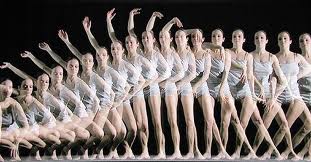Principles of Art
Basic info
Principles of Art
Movement
Movement leads the eye to various places in a design. Have you ever watched a conductor with an orchestra?
By sweeps of the conductor’s arms, he or she leads various musicians through a music score. Often short, choppy strokes are made, and curved and straight lines are suggested. These arm movements are a language that tell the musicians how certain parts of the music are to be played, how different notes are to be stressed, and so on. The arm movements suggest feelings such as sadness, joy, and excitement.
Movement in design can be suggested by overlapping shapes, like these ones captured by strobe photography.

The model was photographed as each new position was taken, and a flow has been created by overlapping the images. This photograph shows how you can give a picture this fluid feeling. (Computer software can be used to create similar effects.)
Artists can make you look at particular things and locations in a picture by working with the elements of art. Sometimes, they want you to look several times at one spot, and your eye keeps going back to this area. The area artists want you to look at might be more detailed, or the color might be lighter or darker, or it might be the spot where the most action is taking place. Limbs and faces can lead your eyes there. Where and how is your attention focused in the pictures that follow?


By sweeps of the conductor’s arms, he or she leads various musicians through a music score. Often short, choppy strokes are made, and curved and straight lines are suggested. These arm movements are a language that tell the musicians how certain parts of the music are to be played, how different notes are to be stressed, and so on. The arm movements suggest feelings such as sadness, joy, and excitement.
Movement in design can be suggested by overlapping shapes, like these ones captured by strobe photography.

The model was photographed as each new position was taken, and a flow has been created by overlapping the images. This photograph shows how you can give a picture this fluid feeling. (Computer software can be used to create similar effects.)
Artists can make you look at particular things and locations in a picture by working with the elements of art. Sometimes, they want you to look several times at one spot, and your eye keeps going back to this area. The area artists want you to look at might be more detailed, or the color might be lighter or darker, or it might be the spot where the most action is taking place. Limbs and faces can lead your eyes there. Where and how is your attention focused in the pictures that follow?


In the baseball picture, the head of the baseball player is looking up, which leads your eyes to look up to see the hit baseball. In the hockey picture, the two players are looking downward and both have their hockey sticks on or near the ice. This leads your eyes to the bottom of the picture, searching for the puck.
Feelings of movement can also be achieved with vertical lines to suggest up and down, and with diagonal lines to suggest movement along sloping lines.
Movement can be achieved by using value differences. Shapes can be painted from light to dark, or from dark to light. That will lead the eye in a front-to-back or back-to-front motion.
Complementary colors are useful for creating movement, and so are contrasting cool and warm colors.
Feelings of movement can also be achieved with vertical lines to suggest up and down, and with diagonal lines to suggest movement along sloping lines.
Movement can be achieved by using value differences. Shapes can be painted from light to dark, or from dark to light. That will lead the eye in a front-to-back or back-to-front motion.
Complementary colors are useful for creating movement, and so are contrasting cool and warm colors.